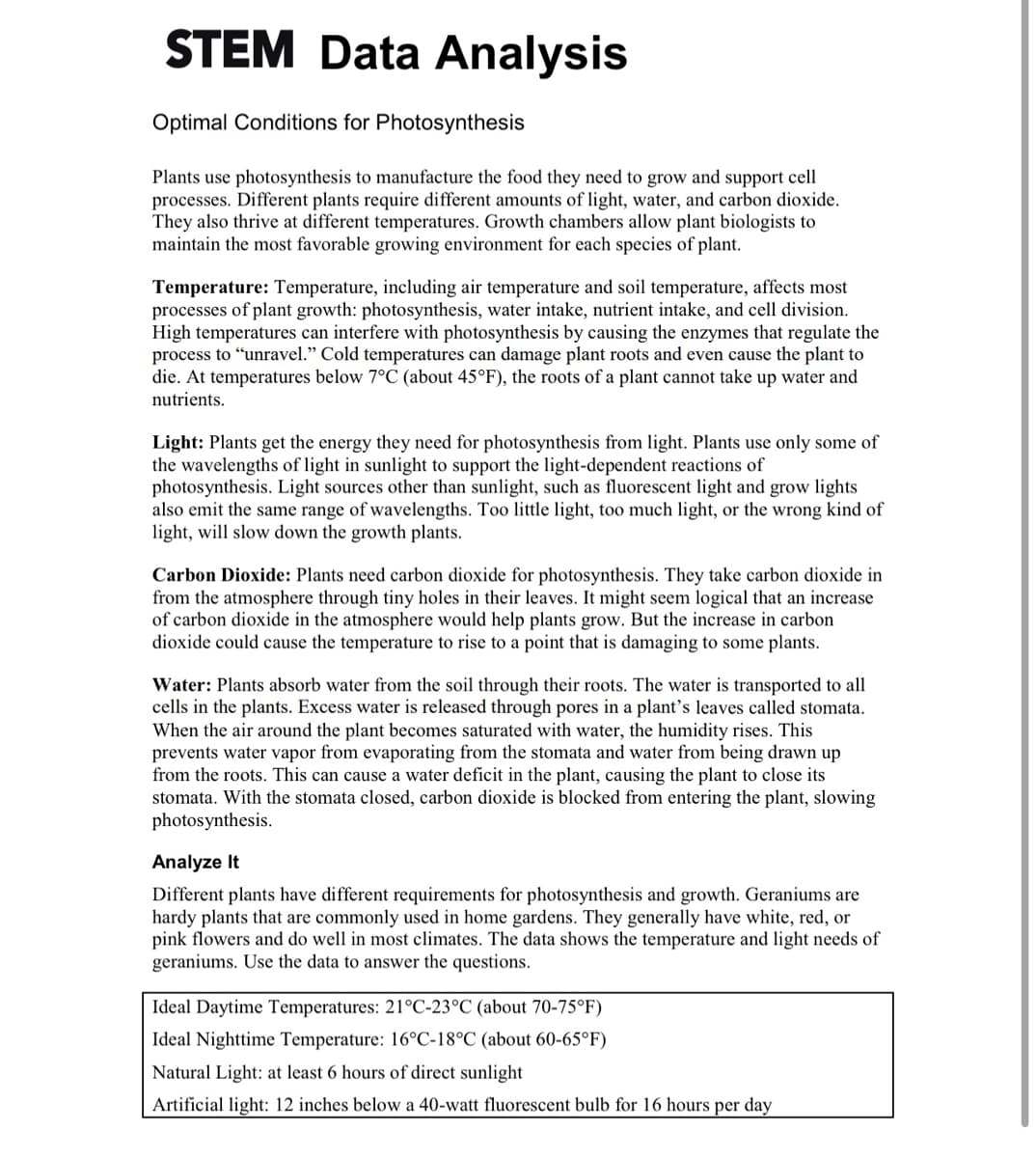aden grows geraniums in his greenhouse. He has noticed that his flowers are not growing very well. The greenhouse is in the shade for much of the day and maintains a temperature of 23°C (74°F). What might be the problem and how could Jaden do to fix it?
aden grows geraniums in his greenhouse. He has noticed that his flowers are not growing very well. The greenhouse is in the shade for much of the day and maintains a temperature of 23°C (74°F). What might be the problem and how could Jaden do to fix it?
Biology: The Unity and Diversity of Life (MindTap Course List)
14th Edition
ISBN:9781305073951
Author:Cecie Starr, Ralph Taggart, Christine Evers, Lisa Starr
Publisher:Cecie Starr, Ralph Taggart, Christine Evers, Lisa Starr
Chapter28: Plant Nutrition And Transport
Section: Chapter Questions
Problem 4DAA: TCE Uptake by Transgenic Plants Plants used for phytoremediation take up organic pollutants, then...
Related questions
Question
100%
Jaden grows geraniums in his greenhouse. He has noticed that his flowers are not
growing very well. The greenhouse is in the shade for much of the day and maintains a
temperature of 23°C (74°F). What might be the problem and how could Jaden do to fix
it?

Transcribed Image Text:STEM Data Analysis
Optimal Conditions for Photosynthesis
Plants use photosynthesis to manufacture the food they need to grow and support cell
processes. Different plants require different amounts of light, water, and carbon dioxide.
They also thrive at different temperatures. Growth chambers allow plant biologists to
maintain the most favorable growing environment for each species of plant.
Temperature: Temperature, including air temperature and soil temperature, affects most
processes of plant growth: photosynthesis, water intake, nutrient intake, and cell division.
High temperatures can interfere with photosynthesis by causing the enzymes that regulate the
process to "unravel." Cold temperatures can damage plant roots and even cause the plant to
die. At temperatures below 7°C (about 45°F), the roots of a plant cannot take up water and
nutrients.
Light: Plants get the energy they need for photosynthesis from light. Plants use only some of
the wavelengths of light in sunlight to support the light-dependent reactions of
photosynthesis. Light sources other than sunlight, such as fluorescent light and grow lights
also emit the same range of wavelengths. Too little light, too much light, or the wrong kind of
light, will slow down the growth plants.
Carbon Dioxide: Plants need carbon dioxide for photosynthesis. They take carbon dioxide in
from the atmosphere through tiny holes in their leaves. It might seem logical that an increase
of carbon dioxide in the atmosphere would help plants grow. But the increase in carbon
dioxide could cause the temperature to rise to a point that is damaging to some plants.
Water: Plants absorb water from the soil through their roots. The water is transported to all
cells in the plants. Excess water is released through pores in a plant's leaves called stomata.
When the air around the plant becomes saturated with water, the humidity rises. This
prevents water vapor from evaporating from the stomata and water from being drawn up
from the roots. This can cause a water deficit in the plant, causing the plant to close its
stomata. With the stomata closed, carbon dioxide is blocked from entering the plant, slowing
photosynthesis.
Analyze It
Different plants have different requirements for photosynthesis and growth. Geraniums are
hardy plants that are commonly used in home gardens. They generally have white, red, or
pink flowers and do well in most climates. The data shows the temperature and light needs of
geraniums. Use the data to answer the questions.
Ideal Daytime Temperatures: 21°C-23°C (about 70-75°F)
Ideal Nighttime Temperature: 16°C-18°C (about 60-65°F)
Natural Light: at least 6 hours of direct sunlight
Artificial light: 12 inches below a 40-watt fluorescent bulb for 16 hours per day
Expert Solution
This question has been solved!
Explore an expertly crafted, step-by-step solution for a thorough understanding of key concepts.
This is a popular solution!
Trending now
This is a popular solution!
Step by step
Solved in 2 steps

Knowledge Booster
Learn more about
Need a deep-dive on the concept behind this application? Look no further. Learn more about this topic, biology and related others by exploring similar questions and additional content below.Recommended textbooks for you

Biology: The Unity and Diversity of Life (MindTap…
Biology
ISBN:
9781305073951
Author:
Cecie Starr, Ralph Taggart, Christine Evers, Lisa Starr
Publisher:
Cengage Learning

Biology: The Unity and Diversity of Life (MindTap…
Biology
ISBN:
9781337408332
Author:
Cecie Starr, Ralph Taggart, Christine Evers, Lisa Starr
Publisher:
Cengage Learning

Biology (MindTap Course List)
Biology
ISBN:
9781337392938
Author:
Eldra Solomon, Charles Martin, Diana W. Martin, Linda R. Berg
Publisher:
Cengage Learning

Biology: The Unity and Diversity of Life (MindTap…
Biology
ISBN:
9781305073951
Author:
Cecie Starr, Ralph Taggart, Christine Evers, Lisa Starr
Publisher:
Cengage Learning

Biology: The Unity and Diversity of Life (MindTap…
Biology
ISBN:
9781337408332
Author:
Cecie Starr, Ralph Taggart, Christine Evers, Lisa Starr
Publisher:
Cengage Learning

Biology (MindTap Course List)
Biology
ISBN:
9781337392938
Author:
Eldra Solomon, Charles Martin, Diana W. Martin, Linda R. Berg
Publisher:
Cengage Learning

Biology Today and Tomorrow without Physiology (Mi…
Biology
ISBN:
9781305117396
Author:
Cecie Starr, Christine Evers, Lisa Starr
Publisher:
Cengage Learning


Biology 2e
Biology
ISBN:
9781947172517
Author:
Matthew Douglas, Jung Choi, Mary Ann Clark
Publisher:
OpenStax